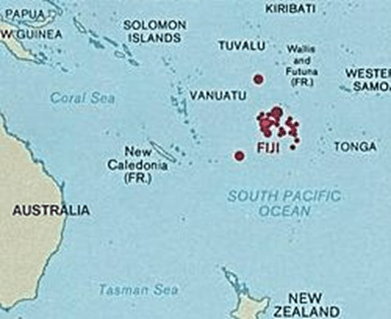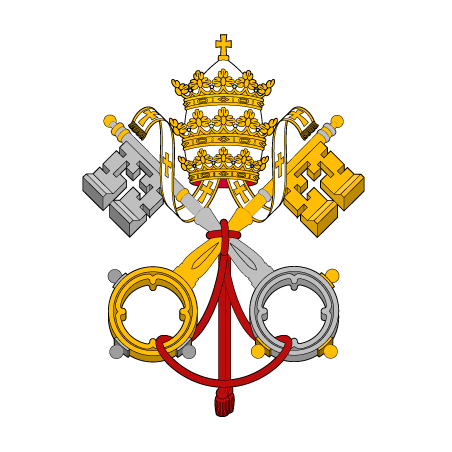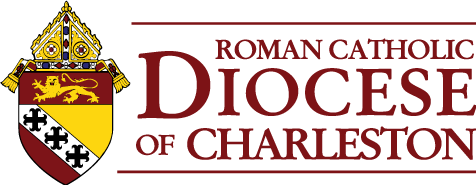Mission Trip for Propagation of the Faith
When Msgr Edward Lofton left me a phone message to plan for a trip in October, I had no idea what was in store for me, just a sense that it might be significant. When he told me he was asking me to go on a mission trip to Fiji as part of Diocese of Charleston Propagation of the Faith, I was overwhelmed. I have admired the work the Msgr. Lofton does for several years. He serves as pastor of St. Theresa the Little Flower parish in Summerville, SC, chaplain and “cheerleader” for the Knights of Columbus, and director of the diocesan office for the Propagation of the Faith.
Msgr. Lofton and Helena Moniz, coordinator for the office of the Propagation of the Faith, have worked since 2010 in Fiji, helping to fund and rebuild the church for the village of Naselesele, Taveuni, Fiji, bringing the Gospel of Christ to students through Catholic education at four residential schools, and now building a new smaller parish church in Nawi.
It all started as an accident.
Apparently Msgr. Lofton was on his way to Hawaii to write a book when he missed his flight. Through divine providence he opted to go to Fiji where he met Marist missionary priest Fr. John Crispin at the Holy Cross parish in Wairiki, Taveuni, Fiji. Fr. John invited support to rebuild the church in the small village of Naselesele, and after meeting with the parishioner building committee, Msgr. Lofton agreed. There was tremendous need for physical and educational resources which continue today.
And now he’s asking me.
The idea of going to Fiji now or ever had never occurred to me. Moreover, even though I work for Our Sunday Visitor, and am a parishioner in the diocese of Charleston, I am a very flawed Catholic. So I am trying to open myself to this journey and to the experience of learning about the experience of the people of Fiji and their Catholic journey. The big journey starts tonight and I am awestruck with the idea of the responsibility we have as missionaries of the Catholic church. My first thought is to pray the rosary and maybe look up some details to make sure I actually do it properly.
So where is Fiji, anyway?
If you are like me, you have some concept that Fiji is way out in the Pacific somewhere. Prior to this I knew about Vijay Singh because I like golf, and then more recently the Fiji team won the Olympic rugby gold medal. But I didn’t know anything about Fiji.
The Republic of Fiji is part of Oceana and is 1100 nautical miles northeast of the north island of New Zealand. It’s an archipelago of 330 islands, of which 110 are permanently inhabited. Population is over 900,000 people, 87% of who live on two of the islands: Viti Levu and Vanua Levu. There is a developed economy consisting of forestry, minerals and fishing. The Dutch first visited in 1643 and later Europeans visited during the 17 th century. The British established the colony of Fiji in 1874 and it was held as a crown colony until 1970.
 The Methodist church first sent missionaries via Tonga in 1835, and the Holy See assigned Fiji to the Marists in 1844. Marist missionary priests worked to establish churches and teach the Catholic Faith from 1844 until today. The Marist priests continue to preside at four parishes in Fiji, including Holy Cross in Wairiki on Taveuni.
The Methodist church first sent missionaries via Tonga in 1835, and the Holy See assigned Fiji to the Marists in 1844. Marist missionary priests worked to establish churches and teach the Catholic Faith from 1844 until today. The Marist priests continue to preside at four parishes in Fiji, including Holy Cross in Wairiki on Taveuni.
The history was very challenging. Tribes were constantly at war and cannibalism was common. Prisoners of war were roasted and eaten. Temples had sacrificed human bodies under them to invoke the gods to support the structure. Fiji was commonly known as the “Cannibal Isles” to explorers. Today Fiji is a major contributor to United Nations peacekeeping efforts.
Msgr. Lofton shares a story that would be funny if it weren’t so horrifying. Apparently the natives did not care for the original missionaries because they were too tough to eat, no matter how much they boiled them. They did not recognize that shoes are not edible!
It was a divine inspiration that led a Marist missionary to tell the chief in the village of Somosomo to erect an enormous wooden cross so God would protect them from the invading Tongan tribes. A hurricane thwarted the Tongans from reaching land, and in thanksgiving the chief required all villages to convert to Catholicism.
Today Fiji is about 45% protestant, which includes 36% Methodist. 25% are the Sanatan Sect of Hindu. About 9% Catholic and a mix of other denominations.
We are going to the island of Taveuni, an island about 30 miles long by 15 miles wide. Msgr. Lofton tells me the connecting flight from Nadi to Matei is on a plane held together by duct tape!
The island is 60% Catholic and has Catholic schools with 1000 students, 90% of whom are Catholic. Through efforts led by the diocese of Charleston Propagation of the Faith, the old timber church in Naselesele was razed and a new stone church has been completed. Msgr. Lofton was invited by the Archbishop to say the first Mass in the then partially completed church in 2012. The schools are in poor condition, although through the support of the work of Msgr. Lofton many improvements have been made to the schools.
There is ongoing need for support. The situation here is far different from cities such as Suva or Nadi where the focus is on technology for students. Here teachers have no materials. Handouts are collected after each class. Students do not have pens or pencils. Most of their parents are not able to read or write. There are no desks in the elementary of middle schools.
During our visit this week we will review progress on a new church being built on the south edge of Vanua Levu in Nawi.
We also will visit with catechists and priests and at least one tribal chief. I am carrying a variety of articles, pamphlets, prayer cards and educational resources to review with catechists and priests. Some of them will be useful in English, but to be truly effective any resources need to be translated into Fijian. Without resources, catechesis is inconsistent and consists of a variety of copied resources and catechist’s own memories.
There is much to do. I’m sure I will be the one who gets the education on this trip!
.jpg)
.jpg)

.jpg)
